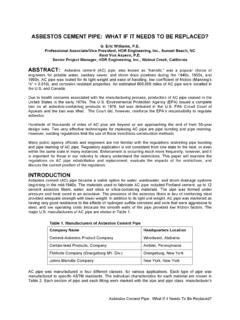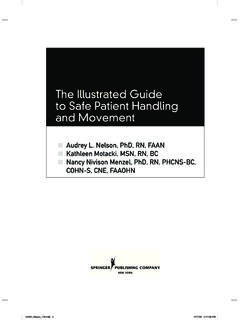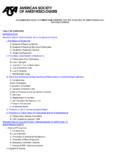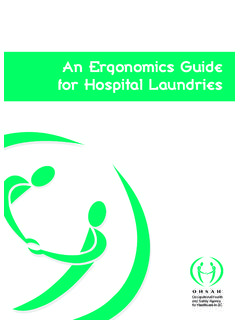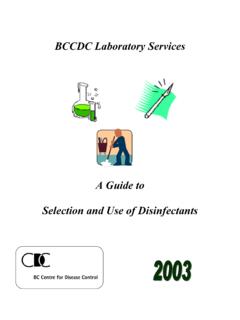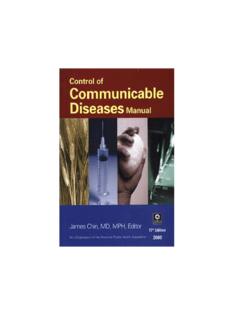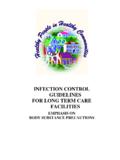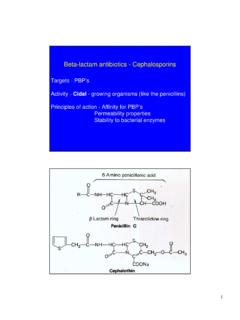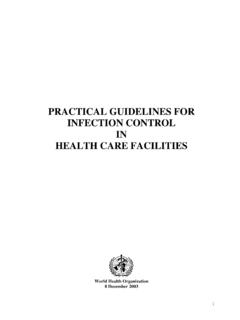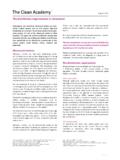Transcription of INFECTION CONTROL IN BURN PATIENTS - …
1 INFECTION CONTROL IN burn PATIENTSA uthors: Joan Weber, RN, BSN, CIC INFECTION CONTROL Coordinator, Shriners Burns Hospital, Boston,Massachusetts; Albert McManus PhD, Senior Scientist (retired), Army Institute of Surgical Research,San Antonio, Texas; Nursing Committee of the International Society for burn InjuriesIntroductionInfection in the burn patient is a leading cause of morbidity and mortality and remains one of the mostchallenging concerns for the burn team. The importance of preventing INFECTION has been recognized inorganized burn care since it s inception and has followed recurring themes through the years.
2 Theseincluded strict aseptic technique, use of sterile gloves and dressing materials, wearing masks for dressingchanges, and spacial separation of PATIENTS , either using private rooms or Certain practiceshave been discarded, such as routine use of prophylactic antibiotics; use of sterile sheets, introducedfollowing the exposure method of burn treatment; and the practice of infrequent dressing changes in theearly post- burn article will provide a comprehensive review of the epidemiology of INFECTION in the burn patient,including factors affecting risk of colonization and INFECTION and outbreaks that have occurred on burnunits.
3 Strategies for INFECTION prevention and CONTROL , including unique characteristics, guidelines forculturing and surveillance, isolation of PATIENTS , environmental concerns, use of antibiotics, andrecommendations for INFECTION prevention at specific sites will be of InfectionThe development of INFECTION depends on the presence of three conditions, a source of organisms; amode of transmission; and the susceptibility of the patient. INFECTION risk for burn PATIENTS is different fromother PATIENTS in several important respects and these differences are included in the discussion of OrganismsSources of organisms are found in the patient s own endogenous (normal) flora, from exogenous sourcesin the environment, and from healthcare personnel.
4 Exogenous organisms from the hospital environmentare generally more resistant to antimicrobial agents than endogenous organisms. Organisms associatedwith INFECTION in burn PATIENTS include gram-positive, gram-negative, and yeast/fungal organisms. Thedistribution of organisms changes over time in the individual patient and such changes can beameliorated with appropriate management of the burn wound and patient. The typical burn wound isinitially colonized predominantly with gram-positive organisms, which are fairly quickly replaced byantibiotic-susceptible gram-negative organisms, usually within a week of the burn injury.
5 If wound closureis delayed and the patient becomes infected, requiring treatment with broad-spectrum antibiotics, theseflora may be replaced by yeasts, fungi, and antibiotic-resistant organisms of particular concern include methicillin-resistant (MRSA), enterococci,group A beta-hemolytic Streptococcus and coagulase negative Staphylococcus. MRSA was first seen inthe United States in the late 1960s and has become an endemic organism in many burn units. It has beenargued that no extraordinary efforts be made to CONTROL its spread, however this view has beenincreasingly challenged in the era of vancomycin-resistant enterococcus (VRE).
6 With the increasingincidence of VRE in hospitals, the risks associated with INFECTION with this organism are increasing. Riskfactors identified in PATIENTS colonized with VRE include prior vancomycin use, prior use of thirdgeneration cephalosporins and antibiotics active against anaerobes, a critically ill patient with severeunderlying disease or immunosuppression, and a prolonged hospital stay. These factors are all presentin PATIENTS with a large burn injury, including prior vancomycin use in units with a high endemic rate organisms have long been known to cause serious INFECTION in burn PATIENTS .
7 Gram-negative bacteremia has been associated with a 50% increase in predicted mortality for PATIENTS withbacteremia compared to those without This is in contrast to gram-positive bacteremia, which2was associated with no increase in predicted mortality. In a subsequent study, it was found that thisincreased risk of mortality could be reversed if the occurrence of the bacteremia was delayed which wasrelated to a longer exposure to the effects of treatment and wound organisms, especially Candida (yeast) species and true fungi (mold) like Aspergillus, Mucor andRhizopus, have been associated with serious infections in burn PATIENTS .
8 Candida colonization appear tobe primarily from endogenous sources while true fungi are ubiquitous in the environment and can befound in air handling and ventilation systems, plants, and of TransmissionModes of transmission include contact, droplet and airborne spread. In burn PATIENTS the primary mode isdirect or indirect contact, either via the hands of the personnel caring for the patient or from contact withinappropriately decontaminated equipment. burn PATIENTS are unique in their susceptibility to colonizationfrom organisms in the environment as well as in their propensity to disperse organisms into thesurrounding environment.
9 In general, the larger the burn injury, the greater the volume of organisms thatwill be dispersed into the environment from the SusceptibilityThe patient has three principal defenses against INFECTION : physical defenses, nonspecific immuneresponses, and specific immune responses. Changes in these defenses determine the patient ssusceptibility to INFECTION . Physical defenses against INFECTION are listed in Table 1 along with changesinduced by burn devices, such as endotracheal tubes, intravascular catheters and urinary catheters, bypass thebody s normal defense mechanisms.
10 In general, pediatric PATIENTS have fewer problems with pneumoniathan do adults because they are less likely to have pre-existing lung damage. INFECTION from intravascularcatheters is of particular concern in burn PATIENTS , as often these lines must be placed directly through ornear burn injured tissue. Catheter associated bloodstream INFECTION (BSI) is caused by organisms whichmigrate along the catheter from the insertion site and colonize the catheter Catheter tips are alsosusceptible to colonization from hematogenous seeding of organisms from the colonized burn of InfectionCatheter-associated BSI rates for burn intensive care units (ICUs) enrolled in the National NosocomialInfections Surveillance (NNIS) System, Centers for Disease CONTROL and Prevention (CDC)
